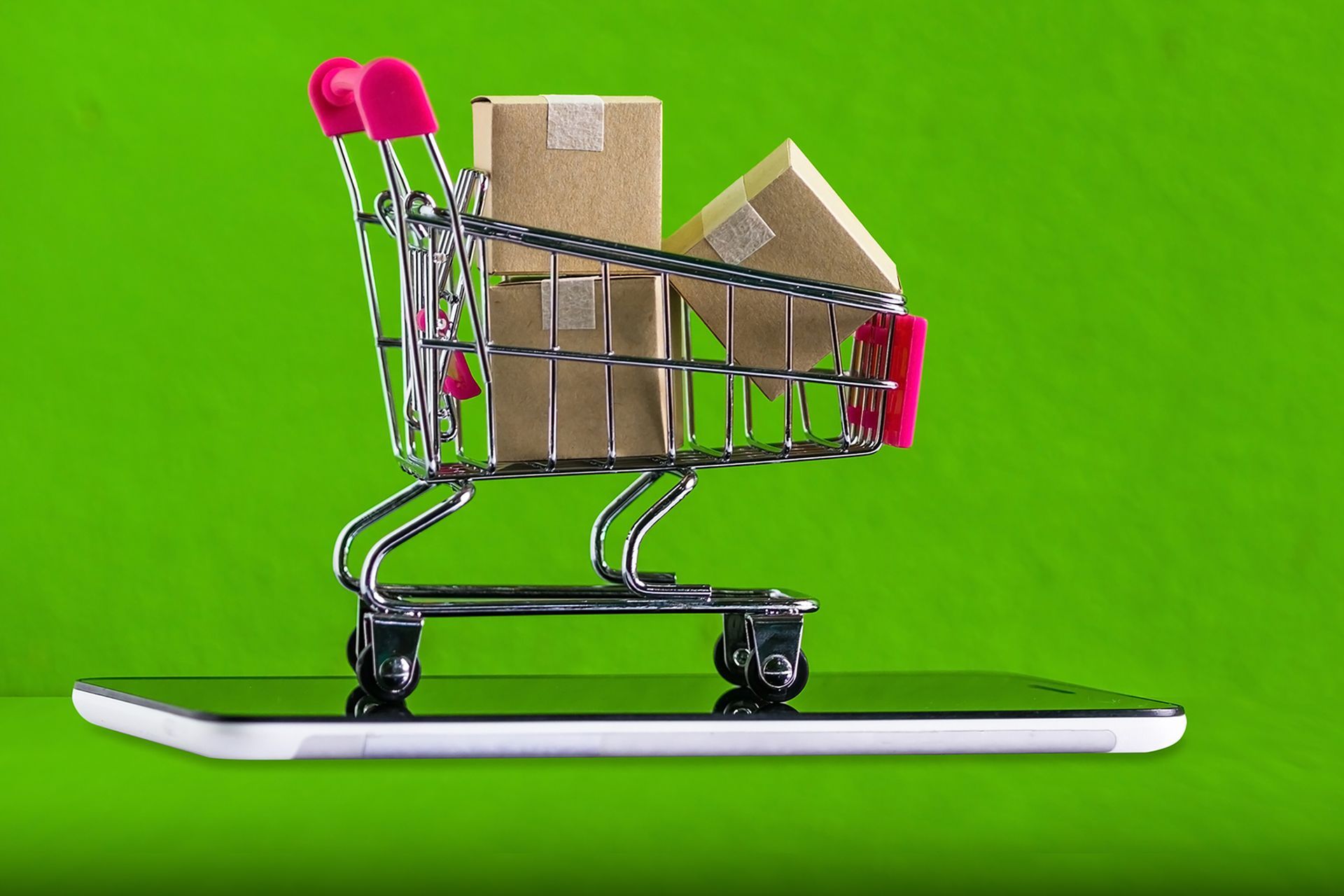Blog Articles

22 Apr, 2024
Mobile continues to play an increasingly important part in eCommerce success. According to Statista forecasts, retail sales from mobile eCommerce (mCommerce) in the UK are expected to exceed £100 billion by 2025, aligning with the widespread use of mobile devices. Customers use their mobiles to investigate purchasing decisions before making purchases in-store or on a desktop, in addition to completing the entire buying journey on their mobile devices. In 2023, nearly all individuals aged 16 to 54 in the UK owned a smartphone, and mobile appears to be the preferred channel for online shopping in the country. Customers’ comfort with mobile buying is ever-increasing, and as a result, the industry cannot disregard mobile’s importance in the eCommerce market when it comes to the design and user experience of their websites. Integrating data verification software, such as address verification , can also help create the experiences that keep customers coming back. Mobile sites vs responsive sites You’ve probably seen the “m.website.com” domain before; it denotes a separate mobile website. That means the mobile version of your site is hosted on a different domain from the desktop version. Mobile websites are distinct from the desktop version of your website since they are developed exclusively for mobile devices. Responsive sites are much more inclusive for the modern-day user. Responsive websites can detect the type of device a visitor is using and automatically alter the layout of the content to fit the user’s screen size. Separate mobile sites can be more difficult to manage than responsive sites. Any updates to a single URL in responsive sites are made to that site rather than having to go in and update two distinct sites. Most crucially, a responsive site’s functionality and content are consistent across all versions. There will be no more debates over which features are best for desktop and which are best for mobile. The look and feel of the site will be consistent across the board. If the website is consistent for mobile users, they’ll be able to access all products and services wherever they are, which in turn makes your business completely accessible. Additionally, implementing address lookup software can enhance the user experience you deliver to your customers. Tips to make your website more mobile-friendly Website speed According to research, 53% of customers will abandon a mobile site that takes longer than 3 seconds to load. You can do a few things to discourage the majority of those visitors from abandoning your site due to latency. Above-the-fold components can be served while elements farther down the page are loaded in the background. This is known as lazy loading, and it’s a frequent method for hiding the true loading time. However, when it comes to using lazy loading to hide latency, be mindful. Google warns that if you use lazy loading on your mobile site incorrectly, it may prohibit Google from crawling your content. So make sure you do your homework and get it right. You can also serve smaller-sized images for mobile pages. Techniques such as srcset (which defines a set of images for the browser to choose between, and what size each image is) make it possible to display larger images on desktops while serving smaller versions of the same images on mobile devices. Because you’re offering a smaller total page, you can use this to your advantage to reduce the loading time on mobile devices. Moreover, integrating address lookup software can streamline the user experience by reducing keystrokes by 90%. Minimise forms and make use of address verification The more effort required to complete a form, the less likely users are to complete it. That’s why the first guideline of form design is to make it as short as possible and eliminate all non-essential fields. An address lookup software can make the mobile checkout process so much quicker and easier. Instead of filling in up to 6 individual fields, the customer just begins typing their address (from any point, whether they start with the town or the street number doesn’t matter) and the type-ahead address verification makes suggestions from the first character. Once the correct address has been located using the address finder software, the customer simply needs to select it, and the entire address form will be automatically populated with validated information. Optional fields Consider whether you truly need to add optional fields in your form. Determine what data you truly require rather than what you want. In a perfect world, your form would have no optional fields. By minimizing the information required from customers, especially with the aid of address finder software, you not only enhance their experience by expediting the process but also increase the likelihood of their return. Optimise your mobile eCommerce with address lookup After browsing the above knowledge to optimise your mobile experience, you should consider the many benefits of an address verification or postcode lookup software. The main benefit of using a mobile device is that it’s already right in front of you, whether you’re at home or on the commute to work. Giving customers the ability to enter their full, correct, validated address with just a few keystrokes is the perfect finish to the convenient ease of a mobile commerce experience. It is the quick-fire tool your business needs to increase conversion rates and decrease cart abandonment. And of course, another financial gain your business will receive as a result of an address finder API is a reduction in failed deliveries as the human error of entering the incorrect address will be eliminated. Make payment methods easy Payments can be problematic for mobile users because large number sequences, such as those required for a credit card, are typically challenging to type. Instead, you may invite visitors to create an account on your website, where you can store their credit card information. Although be sure to also offer guest checkout, to avoid deterring customers who just want to get on with the transaction as quickly as possible. You may also make use of mobile payment methods like PayPal, Google Wallet, or Apple Play for customers. Offering wallets not only makes the UX smoother and simpler on mobile devices, but it also increases customers’ trust in your website, an important factor in mobile commerce. Integrating an address finder software into your checkout process can further enhance user experience by automatically suggesting accurate address options in real-time, preventing typos, missing characters and abbreviation. The Fetchify difference We process millions of data transactions weekly for thousands of clients, from small e-commerce start-ups to large household brands such as LG, Heinz and RBS. Our flagship products, Address Lookup and UK Postcode Lookup , reduce friction on checkouts, leading to increases in conversion rates, and help reduce failed deliveries and customer frustration. We are proud to offer fit-for-purpose plug-and-play integrations with most leading business software platforms. We enjoy global coverage in over 250 countries, with businesses from various industries benefiting from our address finder offering. If you’re looking to boost conversion rates, eliminate failed deliveries, minimise human errors, and provide a seamless experience for customers on your platform, then look no further than the experts in customer data validation and address verification solutions – Fetchify. The best part is you can try out our 14-day Free Trial before committing to our services. Our excellent technical and customer support team is on hand to answer your burning questions. Make sure to Get in Touch and experience the Fetchify difference – like thousands of e-commerce businesses around the globe.

15 Apr, 2024
Have your customers ever ordered something online and eagerly awaited its arrival, only to discover it was lost or delivered to the wrong address? It can be frustrating and time-consuming to deal with failed deliveries, and it's an issue that affects both customers and businesses. In fact, Citizens Advice recently reported that over 13 million people faced a delivery problem with the last parcel they received. But what if we told you that many of these issues could be prevented simply by using an address lookup software at checkout? It's true – if someone inputs the correct address at checkout, there will be fewer delivery failures. This is because delivery companies rely on accurate address information to deliver packages to the correct location. When a package is delivered to the wrong address, it not only causes frustration for the customer but also results in a loss for your business. That's where address lookup and data validation products come in. Another report by Channel X revealed that 12% of UK residents experience missing parcels, and a third of UK residents reported concerns about sending or receiving parcels due to loss or theft. By using a reliable postcode lookup and data validation service like Fetchify, you can minimise these risks and provide your customers with a better experience. Why entering the correct address at checkout is crucial Entering the correct address at checkout is crucial to ensuring a smooth delivery process. When a customer inputs an incorrect or incomplete address, it can lead to a range of problems that can cause delivery failure. For example, if a customer accidentally inputs the wrong postal code or street name, the courier may not be able to find the correct address and may end up delivering the package to the wrong location. Additionally, incomplete addresses can also cause problems. If a customer forgets to input their apartment or unit number, the courier may not be able to deliver the package to the correct recipient. Incomplete addresses can also lead to packages being returned to the sender if the courier is unable to deliver the package to the intended recipient. However, with the integration of address finder software at checkout, many of these issues could be prevented simply by ensuring accurate address input. Delivery failures caused by incorrect or incomplete addresses can lead to a range of negative consequences. The package may be delayed or lost, which can result in frustration and dissatisfaction for the customer. It can also result in additional costs for the merchant or courier, who may need to resend the package or refund the customer. Ultimately, delivery failures can damage your reputation and result in lost business. Ensuring that customers enter accurate and complete addresses at checkout is essential for reducing delivery failures. Address lookup and data validation software play a pivotal role in this process. By integrating these products into the checkout process, you can automatically validate and correct customer addresses in real-time, ensuring that the correct information is captured and reduce the risk of delivery failures. Merchants can leverage postcode lookup and data validation products to ensure accurate and complete address information is captured during the checkout process, reducing the risk of delivery failure and improving customer satisfaction. How losses are reduced with accurate address lookup at checkout When online customers enter correct delivery addresses at checkout, it can lead to several benefits that help businesses reduce losses. Here are a few ways this can happen: Fewer failed deliveries When the customer's address is correct, it’s more likely that the delivery will be successful. This means that the package won’t need to be returned to the seller due to an incorrect or incomplete address, reducing the risk of failed deliveries. Reduced shipping costs Failed deliveries can be expensive for businesses, as you may need to pay for the package to be shipped back and then re-shipped to the customer once the correct address is obtained. By integrating an address finder tool and reducing the number of failed deliveries, you can save on these extra shipping costs. Improved customer satisfaction When a customer receives their package on time and without any issues, it can lead to increased satisfaction and loyalty. In contrast, failed deliveries can result in frustrated customers, negative reviews, and a damaged reputation. By incorporating a postcode lookup software and ensuring that the customer's address is correct, you can improve the overall experience for the customer and reduce the risk of negative feedback. Reduced fraud risk Correct addresses can also help reduce the risk of fraud. By validating the customer's address at checkout using an address finder tool, businesses can ensure that the package is being shipped to an existing address. This can help prevent fraudulent orders and reduce the risk of chargebacks. In a nutshell, entering correct delivery addresses at checkout can lead to significant benefits for both businesses and customers. The Fetchify difference Fetchify offers fast, accurate and intuitive customer data verification software to help businesses save time, work even smarter and deliver a superb customer experience. Data verification products help you reduce failed deliveries and boost checkout conversion, too. These are also easy to integrate with most leading business software platforms through plug-and-play integrations – such as Magento, BigCommerce, and WooCommerce. This means that businesses can easily incorporate Fetchify's products into their existing systems without having to make significant changes to their workflow. Failed deliveries can be a significant issue for businesses, resulting in lost revenue and frustrated customers. However, by using address finder and data validation software like Fetchify, businesses can ensure that their customers' addresses are accurate, reducing the possibility of failed deliveries. With easy integration with a variety of platforms, it's a solution that's accessible to businesses of all sizes. We process millions of data transactions weekly for thousands of clients, from small e-commerce start-ups to large household brands such as LG, Heinz and RBS. Our flagship products, Address Lookup and UK Postcode Lookup , reduce friction at checkout, leading to increases in conversion rates, and help reduce failed deliveries and customer frustration. We enjoy global coverage in over 250 countries, with businesses from various industries benefiting from our address finder offering. If you’re looking to boost conversion rates, eliminate failed deliveries, minimise human errors, and provide a seamless experience for customers on your platform, then look no further than the experts in customer address data validation and postcode lookup solutions – Fetchify. The best part is you can try out our 14-day Free Trial before committing to our services. Our excellent technical and customer support team is on hand to answer your burning questions. Make sure to Get in Touch and experience the Fetchify difference – like thousands of e-commerce businesses around the globe.

08 Apr, 2024
As an online business owner, you know how important it is to capture accurate customer data during the checkout process. Not only does it help with shipping and billing, but it can also help with marketing efforts in the future. However, manually entering information can be a hassle, and even minor typos can lead to failed transactions and lost sales. E-commerce entrepreneurs know how important it is to have a smooth and seamless checkout process. The last thing you want is for potential customers to abandon their carts due to a cumbersome and frustrating checkout experience. One of the most significant factors that can cause customers to abandon their carts is the hassle of filling out long and complicated forms during checkout. This is where Fetchify’s address lookup and data validation solutions come in to play. Fetchify can help increase checkout conversions with its range of fast, accurate and intuitive data verification products. With various integrations for the leading eCommerce, CRM, and software platforms, streamlining your checkout process couldn’t be simpler. Our software products include global address auto-complete, UK postcode lookup, geocodes, eircodes as well as phone, bank, and email address validation – ensuring that the customer data you collect is accurate and up-to-date. Let’s dive into some details of how Fetchify can help to increase your web conversions. Reduce the Hassle of Form Entry We all know how tedious it can be to fill out long checkout forms, especially on mobile devices. With our address finder , you can reduce keystrokes by up to 90%, making the checkout process faster and easier for your customers. Not only does this save your customers’ time, but it also reduces frustration and increases the chances of completing a purchase. Fetchify’s address lookup helps businesses capture the most accurate addresses at checkout while reducing the time and effort it takes for customers to enter their address information, resulting in faster and more accurate order fulfilment, reduced cart abandonment rates, and increased customer satisfaction. Validate Email Addresses Email marketing is an important part of any business’s marketing strategy, but it’s only effective if the email addresses are correct. Fetchify’s email address validation helps ensure that the email addresses collected during the checkout process are accurate and valid. This reduces the likelihood of bounced emails and increases the chances of successful email marketing campaigns. By reducing friction through email address validation, streamlining the checkout process, and ensuring accurate customer data capture, we help increase conversions in the checkout process. Every sale, and all increases in your conversion rate can have a significant impact on your bottom line. Reduce Friction and Human Errors Friction in the checkout process can be a major barrier to completing a sale. Our address lookup and data validation products help to reduce friction by streamlining the checkout process , making it easier for customers to complete their purchases. The less friction there is, the more likely customers will complete their purchase and become repeat customers. Fetchify’s address verification software uses real-time address finder and geocoding to help customers quickly and easily fill out their address information during checkout – thus reducing friction effortlessly. When a customer starts typing their address into the form, our address verification software suggests, in real-time, complete and verified addresses. This allows customers to select their address from a dropdown menu instead of typing it out manually – lowering the likelihood of human error like typos, missing characters and abbreviation. Purchase Faster with Address Lookup In today’s fast-paced world, every second counts, especially when it comes to making a purchase online. A slow and tedious checkout process can lead to frustration and cart abandonment, ultimately affecting your business’s bottom line. Time really is of the essence when it comes to completing an online purchase. Fetchify’s address verification and data validation products can help speed up the checkout process, reducing the chances of cart abandonment. The faster the checkout process, the more likely customers are to make a purchase. Manually entering an address during checkout can be time-consuming and frustrating for customers. Our address finder functionality reduces the number of keystrokes required to enter an address. This will ensure that customers can quickly and easily find their address and complete the form with just a few clicks. With Fetchify, you can reduce the time it takes for your customers to enter their details during checkout, ultimately leading to a faster purchasing process. Speed of Checkout vs Conversion Rate The Baymard Institute found that on average, an e-commerce cart abandonment rate is about 70%. The study found that among the top reasons for cart abandonment, a lengthy and complicated checkout process was a leading cause. A study by Google revealed that 53% of mobile site visitors would leave a page that takes longer than three seconds to load. A slow checkout process can be a major contributor to this and negatively affect conversion rates. This is further illustrated by research conducted by Kissmetrics, who discovered that every one-second delay in page load time could result in a 7% reduction in conversions. Essentially, these studies reveal that even small improvements to the checkout process can significantly impact sales – the longer it takes for a customer to complete a purchase, the more likely they are to abandon their cart. Fetchify’s address finder and other data validation products like email address validation can help speed up the checkout process, reducing the chances of cart abandonment and increasing conversion rates. The Fetchify difference With global e-commerce sales projected to reach over $6.9 trillion by 2025, online businesses that can streamline their checkout process are likely to see significant revenue gains through increased conversions. It is clear that a faster and simpler checkout process can be a major driver of sales and conversions for e-commerce businesses. By using a service like ours to streamline the address verification and data validation process, businesses can significantly reduce the time it takes for customers to complete their purchases and improve the overall checkout experience. Reducing the time it takes for customers to enter their information will undoubtedly improve your conversion rate and ultimately boost your sales. Your business will benefit from a more efficient and precise user journey, with happier customers, a greater rate of successful deliveries, and a remarkable increase in sales from returning customers. We process millions of data transactions weekly for thousands of clients, from small e-commerce start-ups to large household brands such as LG, Heinz and RBS. Our flagship products, address lookup and UK postcode lookup , reduce friction on checkouts, leading to increases in conversion rates, and help reduce failed deliveries and customer frustration. Moreover, with our email address verification , you can improve the quality of your data and prevent invalid or incomplete account registration. We are proud to offer fit-for-purpose plug-and-play integrations with most leading business software platforms. We enjoy global coverage in over 250 countries, with businesses from various industries benefiting from our address verification offering. If you’re looking to boost conversion rates, eliminate failed deliveries, minimise human errors, and provide a seamless experience for customers on your platform, then look no further than the experts in customer data validation and address finder solutions – Fetchify. The best part is you can try out our 14-day free trial before committing to our services. Our excellent technical and customer support team is on hand to answer your burning questions. Make sure to get in touch and experience the Fetchify difference – like thousands of e-commerce businesses around the globe.

17 Sep, 2023
Over time, businesses evolve. New products are created, and new customers won. And, as a business evolves and matures, so too does its purpose, its identity, and its appearance. Back in 2008, when the business now known as Fetchify was launched, we were called Crafty Clicks. That identity was perfect for an early-stage, disruptive start-up – but in 2020, we felt it was time for a new name to reflect where the business had evolved to. Fetchify was born, because we ‘fetch’ and ‘verify’ data for our customers. The name change coincided with our acquisition by software and payments group ClearCourse, and over the past year, we’ve been working on a whole new brand identity that reflects a ‘grown up’ Fetchify. Of course, we’re still the same people with the same great range of products, but our new visual identity demonstrates that we’re part of ClearCourse, and aligned with the group’s purpose of helping our customers build great businesses with industry-specific software. Our new logo, which utilises a modern, sans-serif font, incorporates the ClearCourse compass, which points north-east – a sure sign in business that things are moving in the right direction.

17 Sep, 2023
Fetchify is headed to London’s eCommerce Expo this month – and, alongside our market-leading range of data verification software we’ll be debuting our brand-new look. The eCommerce Expo, which takes place at ExCeL London on 27-28 September, is the UK’s only event that covers everything related to online trade. It attracts more than 11,000 B2B and B2C senior eCommerce professionals across the two days, and the theme of this year’s event is ‘The Future of eCommerce’. “This is an incredibly important event in the calendar, and attracts the top eCommerce brands as well as the very best tech providers,” says Andre Venter, Product Director of Fetchify. “We’re looking forward to reconnecting with current customers as well as introducing Fetchify’s range of data verification products to potential new clients. “For eCommerce clients, Fetchify can add a tremendous amount of value, by helping increase online conversion, improve delivery accuracy, enhance data quality and saving money, and we’re looking forward to demonstrating this face-to-face.” The eCommerce Expo, which features a number of high-profile speakers from brands including Adobe, Specsavers, Ralph Lauren and Dominos, will also see the first outing for Fetchify’s new look, after undergoing a makeover during 2023. “Our brand aesthetic is incredibly important in communicating the value proposition of Fetchify,” says Andre. “We have a number of software offerings that all enable our clients to achieve different outcomes and it was important for us to share that story clearly in a way that potential clients can easily understand.” Visit the Fetchify team on Stand F45 at the eCommerce Expo at ExCeL London on 27-28 September 2023.

17 Sep, 2023
Write me a tragedy in three words… abandoned shopping carts. Is there anything worse than knowing that a customer got all the way to your checkout and then changed their mind and left the website? Abandoned carts are the greatest tragedy for any eCommerce business. And yet our recent insight report found that a massive 42% of retailers aren’t even measuring this metric. Knowing the extent of the issue is the first step to improving on it and winning back those sales! A third of the surveyed participants that weren’t measuring cart abandonments said it was because they don’t know how. This blog is for you! At Fetchify we talk a lot about helping businesses to improve checkout conversion rates (reducing abandonment rates) but today we’re going to take a step back and look at measuring those rates so you have your starting point to improve from. What are conversion rates and abandonment rates? So the first thing to understand about these metrics is that they are two sides of the same coin – conversions are the customers that started the checkout process and completed the transaction, abandonments are the people that started the checkout process but then left without making a purchase. We don’t just want to celebrate conversions, we want to tackle the abandonment rate – the money that is walking away from your checkout. Everything about your online shop is carefully designed to entice the visitor, to persuade them to buy your products. How many potential customers are being won over by your website and your products, adding items to their basket, but then being put off by something in the checkout journey and leaving? How do you measure your abandonment rate? Depending on your eCommerce platform, your metrics and reports will take different forms, but have a look at your specific reporting and find these two important numbers. The number of initiated transactions – that is the number of visitors who place items in their basket The number of completed transactions Then you need this simple equation to work out your aban donment rate: 1 – (number of completed transactions / number of initiated transactions) x100 = abandonment rate Once you have that figure, you have a black and white incentive in front of you to streamline your checkout UX and win back those customers before they leave. A clear indicator of the ROI to be g ained through conversion rate optimisation. How does your store measure up? The industry average across eCommerce is an abandonment rate of 68%. That’s 68 out of every 100 customers that start the checkout journey and then leave without finishing the transaction. How does your store measure up? If your abandonment rate is lower than this average congratulations! But that doesn’t mean there isn’t still room for improvement. Every tweak that makes your checkout more user-friendly, will convince more potential customers to stick with you and cross the finish line of the transaction. A high abandonment rate can indicate issues with your checkout process that are turning customers away. Perhaps your shipping costs are too high, your payment options don’t meet expectations, or your forms are too long and challenging. But now you know what your starting point is, you will be able to tell if any adjustments you make are improving the experience for your customers. They will tell you with their wallets. The good news is, we can help 57% of the businesses we surveyed in our Checkout Insight Report claimed a higher than average conversion rate/lower than average abandonment rate. Of the adjustments they had made to improve their checkout, the three ranked most highly by our participants were : Address Lookup t o speed customers through form-filling Abandoned cart discounts to entice customers back Alternative payment optio ns such as digital wallets to make payments easier and suit any preference. If you are already a Fetchify customer, you are already ahead of the curve. Our Address Auto-Complete API, when added to your checkout means your customers can add their shipping and billing addresses with fewer keystrokes. That means less dwell time and less time to reconsider a purchase. Getting customers through your checkout quickly and efficiently is the key to great conversion and our Address Auto-Complete can reduce keystrokes by as much as 80%. Sound good? You’re just a few simple steps from a better optimised checkout and even better conversion rates. Get in touch today .

17 Sep, 2023
Mobile users make up more than 50% of web traffic. In fact during the Black Friday and Cyber Monday weekend 2021, mobile accounted for over 68% of online retail traffic. The pandemic has only increased this weighting. Working from home has made desktop devices feel like the office. Mobiles feel like a place to catch up with friends, play games, and shop. Mobile eCommerce or mCommerce has an average cart abandonment rate of 86%. That’s 16% higher than desktop devices. With these statistics, it would be easy to simply assume that most mobile visitors are just window shopping, with very low intent to buy. This could be why many eCommerce businesses don’t give enough thought to the mobile checkout journey of their stores. But with mobile traffic volumes increasing all the time, the high abandonment rate will hurt businesses more and more. Savvy eCommerce managers could make modifications to their checkout to better accommodate mobile shoppers, enticing them to buy. Currently, according to research done by Baymard Institute on average, for every 100 mobile visitors that add an item to a basket, only 14 are completing their purchase. If even 10 of those abandonments are for reasons other than window shopping and could be helped through their checkout journey by small changes, it could make big differences for businesses. According to Baymard, 18% of cart abandonments are due to long and complicated checkout forms. With small screens and cramped keyboards of mobile devices, unwieldy forms are a much greater obstacle. Optimising the checkout user experience for mobile device users is more vital than ever for businesses. Here are our 8 tips for optimising your checkout UX for mobile devices 1. Bigger buttons It is important to make the call-to-action buttons proportionately larger compared to the rest of the screen content on a mobile device than on a larger screen. They need to grab the attention to clearly signpost the visitor through their checkout journey. Bear in mind that most mobile users will be navigating using their thumbs so the buttons must be of a size that takes the average thumb size into account. 2. Vertical alignment and segmentation Make sure customers only need to scroll up and down to navigate checkout, not side to side as well. In fact, it is preferable to have multiple short steps split along several pages rather than one long checkout that needs to be scrolled through. This makes it less likely that a customer will miss a step or an important piece of information. 3. Progress bar Show customers how far they have come and how much they have left to go. They are more likely to complete the checkout journey if they know how much more time and effort it is going to take than if they feel like they are being presented with page after page with no clear direction. 4. Declutter Only ask the absolutely vital information. Depending on your product, is the customer’s birth date really necessary for example? What about a phone number? Only ask for the information that will be used to offer the best service and don’t take up extra time and space asking for unnecessary personal details. Also, consider removing additional prompts such as upsells. The more opportunities customers have to be drawn away from their purchase, the less likely they are to complete the process. 5. Do not force account creation One of the biggest reasons for cart abandonment, on any device, is the need to create an account before checkout. If the customer enjoys their experience and is happy with their purchase, they can choose to sign up later for extra rewards and loyalty schemes. But when it comes to the checkout journey, don’t discourage prospective customers by forcing a sign up when they might just want a one-time purchase. Allow guest checkout and social login options. Particularly on mobile devices, a person’s social media account will be integral to their device and usage, allowing them to sign up using their facebook account saves time and will also immediately provide more of their data without taking any more of their time. 6. Offer wallets Consumers often feel less secure using mobile devices to complete transactions than they do on desktops. Therefore, offering wallets like PayPal and apple pay will reinforce trust in the security of the website as well as speed up the payment process by removing the need to type in long credit card numbers. 7. Display security badges A lock icon, the words “secure checkout”, security badges such as McAfee or Norton, encrypted https instead of http. All of these signs help to build trust with customers and make them feel safer and more secure when providing their personal information and payment details. 8. Address validation One of the biggest challenges with mobile checkout is data capture, the small screens make large amounts of typing unwieldy. Autofill may seem like a clear solution, however, it is still essential to validate the address at checkout to guarantee efficient delivery. For one thing, autofill is not guaranteed to populate forms in the correct order depending on the number of fields in the form and how they compare to the stored information. For another thing, autofill will default to the saved address. If the purchase is a gift, for example, then the customer will need to be able to find and select an address other than their own stored one. An address auto-complete or postcode lookup address validator will find the correct address in just a few keystrokes and ensure it is valid and authentic. Saving precious time that could otherwise have lost a customer, as well as eliminating failed deliveries caused by bad address data.

16 Sep, 2023
Valid email addresses are essential for any company hoping to succeed with email marketing and customer communication. It’s critical to double-check your email address list is correct, error-free, and that the emails actually exist. People make mistakes, it happens, it’s not uncommon for your customers and subscribers to make typos in their email addresses during input. And if these typos go unnoticed and uncorrected into your database, you will not only lose contact with that customer, but also have an overall bad effect on your overall deliverability score as more of your emails bounce. We’ve put together a handy guide advising how to check if an email is valid, why it’s important for your marketing strategies and sales communications, and how Fetchify could make life so much easier for you. What is email validation? Email validation is a method of determining whether or not an email address is reachable and valid. It executes a quick process that detects typos, whether they are honest errors or deliberate misdirection. It also verifies whether a specific email address is associated with a reputable domain. This tool not only checks email addresses at point of entry into your database, it also protects your email sender score, allowing you to get the most out of your email software. It’s not enough to simply be checking for an @ symbol in your email field, or for a full stop and a standardised suffix. These only verify that a customer’s email address is properly formatted. Just identifying correct format doesn’t check if an email address works and is linked to a valid, frequently used inbox. This means you won’t realise it’s invalid until you try to contact the customers or prospect. Whether it’s for signup confirmation or an email campaign, if too many of your emails bounce back, you could end up automatically being filed into junk folders . Why is email validation important? Email marketing is essential for eCommerce firms because it allows you to connect with customers instantly without depending on social media algorithms or search engine results. It has a significantly lower risk than social media advertising. Your subscriber list is yours to keep and your communications are delivered directly to them, even if you switch platforms. That implies you can’t lose your ability to interact with them due to an algorithm change, a failure of an external firm, or an arbitrary ban. Here are some great benefits of email marketing: It boosts brand recognition – consumers who follow you indicate that they are interested in your business. It is incredibly measurable, allowing you to diagnose issues and identify areas where you can improve It’s cost-effective Because some purchasers are in the research, comparison, or ready-to-buy stages, personalised messaging is possible, customised to their stage in the buyer journey. Whether email marketing is your main method of communicating with clients or just one of several different channels, verifying customer email addresses at the time of entry/capture is a primary priority in order to maximise your campaign’s contactable audience and readability. Having verified email addresses could reduce your bounce rate by up to 98% , which is a staggering statistic. It can also help with increasing your conversion rate as you can be sure your campaigns are going to the correct email addresses every time. How Fetchify can help with email validation We are experts in data validation with over 13 years of experience. When you choose us for your email address validation , you can expect immediate results and enhanced engagement. Our systems work worldwide, checking the email that your subscriber has entered is active and deliverable. As incorrect formatting or addresses are rejected in real time, users are prompted to correct the information immediately, allowing for quick and easy corrections to take place and deterring deliberately wrong information. But what about the emails already in your database? Don’t worry, we’ve got your back there too, with our data cleansing service. We can cleanse your existing contact list to reduce bounces caused by old, bad data, as well as ensuring only clean data is added to your database moving forward. Get in touch with our helpful team of experts to find out more about how our email validation and suite of data services can benefit your business.

16 Sep, 2023
Having the correct postcode at the point of payment is crucial for a smooth shopping experience for your customers, and even more importantly, reduced cart abandonment. Using postcode lookup or address auto-complete to capture a full address is far faster and more accurate than customers manually entering their data. However, address lookup isn’t only beneficial for eCommerce businesses, it can also make online processes such as bank account registration and mortgage applications much easier. Reducing any stress and frustration for potential customers is bound to make a positive impact on your business, regardless of what product you have on offer. Benefits of postcode lookup and address validation There are many benefits of using an address lookup API – we’ve listed the top ones here: Compatible across devices From laptops to tablets to smartphones and EPoS kiosks, a postcode address lookup solution works on every internet-enabled device and provides the optimum user experience. Scalable Address lookup technology scales quickly on demand, processing hundreds of enquiries per minute. You can rest assured that our address finder will keep up with your customers even during big seasonal events or Black Friday sales. User location detected Address Auto-complete has the ability to sort results by distance from the user, detect which country users are in, and start with the closest matched addresses. If the customer is buying a gift for a friend overseas, for example, they can easily switch the country and the search tool will focus on matches in the selected country instead of their own location. This enables you to build one checkout form for all of your customers, regardless of where they are in the world. Top tip: If your business trades internationally, choose Address Auto-Complete rather than UK Postcode Lookup to take advantage of our address data for over 240 countries. Why use address validation? Address lookup and validation for customer satisfaction Streamline your checkouts by filling out forms faster and more accurately. Address Auto-Complete can reduce the number of keystrokes by up to 80%, this speeds your customers through the checkout, increasing conversions and reducing basket abandonments. Accurate contact data Collect accurate email addresses and phone numbers to boost customer relations and LTV. This can also have a positive impact on your marketing campaigns. Accurate shipping address data for deliveries You can reduce the number of failed deliveries with accurate address data, putting less stress on your delivery drivers. This in turn reduces wasted costs of reshipment and time handling customer complaints for missing items. Easier and quicker for staff Address and postcode finders are also useful for customer service employees, who are under pressure to search through a database of millions of addresses and locate the relevant location quickly. Businesses will benefit from address and postcode finders because they can quickly filter search results between commercial and residential addresses, enhancing the productivity of direct marketing. Things to consider for improved payment page UX Consider errors If a lot of individuals type O instead of 0 or insert a space where one isn’t needed, their address might not be shown. To avoid this, implement a system that anticipates typical errors like these, ensuring their address is identified, irrespective of any typos. Make sure to update regularly If your address directory isn’t updated on a regular basis, you could be missing out on your customers’ new, updated and changed addresses, which translates to orders that you’re losing by losing touch with your existing customer base. Take advantage of predictive search with Address Auto-Complete Predictive search is far faster than typing out a whole address, displaying relevant addresses and allowing the user to select theirs is key to efficiency. Furthermore, some people may not know the delivery postcode, with Address Auto-Complete, they can start typing from any part of the address and the tool will present addresses as you type. Mobile experience It’s critical that this system functions well on mobile devices, especially since many people shop online using their phones these days. A good mobile UX means that they don’t have to scroll very far, that icons and fields are large enough to click smoothly, that the form works in landscape and portrait mode, that various mobile models’ keyboard features are fully integrated, and that required fields are clearly identified and explained. How Fetchify’s address lookup and data validation works Fetchify can implement a simple address lookup API into your business system, so you never have to worry about customer payments failing due to address errors again! With Address Auto-Complete , your users begin typing at any point of the address and suggestions are presented as they type. With UK Postcode Lookup , all your users have to do is enter their postcode and we’ll display a drop-down menu of matching addresses. Once the user has clicked the correct address, the rest of their details will automatically be filled into their form. For more information get in touch with us and one of our expert team members will be happy to help.
Contact
+44 (0) 333 014 1992
(freephone)
Monday – Friday, 8am-6pm
(GMT London)
Products
Resources
Registered Office: 107 Cheapside, London, EC2V 6DN. Registered in England: 06912469.
© All Rights Reserved ClearCourse Business Services Limited T/A Fetchify.
Trading Terms & Conditions | End User Terms | Privacy Policy | Cookie Policy

